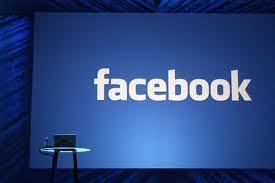Erik Qualman's Blog, page 659
August 3, 2012
Five Tips for Improving Your Social Netiquette

an article from VIV Magazine by Alexa Joy Sherman. Illustration credit: Robyn Neild

Though social media helps us connect, it’s also easy to offend en masse, from online snubs to oversharing.
by Alexa Joy Sherman
More than 900 million people worldwide use Facebook. And why not? You can catch up with hundreds of people you haven’t talked to in years and keep current friends updated on your daily life. Or maybe you’re looking to market yourself with fan pages or news about your promotion du jour.
Whatever your goal, though, be aware: The more social networking you do and the longer your list of “friends,” “followers” and “connections,” the easier it is to inadvertently trip over an invisible boundary and offend someone. Don’t let that happen: Here’s how to network gracefully in the brave new social-media world.
1. DO learn the ropes.
You’re most likely to experience a social disaster as a newbie, so before you start tweeting, pinning and updating, familiarize yourself thoroughly with a site’s inner workings.
For starters, click on Facebook’s “Settings” button to check how much you’re sharing with the world. Pay close attention to the “Privacy Settings.” That’s where you indicate how visible various parts of your profile will be, including your photos, contact information, relationship status, education and work affiliations.
2. DO define your boundaries.
As your roster of friends grows, consider segmenting the list. For example, on Facebook, you can divide your friends into groups. Once you’ve created lists, you can return to your privacy settings and pare down which lists can view various aspects of your profile.
You may also consider using different sites for different purposes: Facebook for friends and family, LinkedIn or Plaxo for colleagues. “Do you really want to let the high-school class clown loose with your business contacts?” asks technology forecaster Paul Saffo, a consulting associate professor in the engineering school at Stanford University.
3. DO spare people’s feelings.
If you don’t want to accept a friend or recommendation request, the least offensive thing to do is often to ignore it. “I don’t add friends unless I meet them in real life, and since there’s always potential for that in the future, I leave these requests queued indefinitely,” says Tamar Weinberg, author of The New Community Rules: Marketing on the Social Web (O’Reilly Media, 2009).
If you feel compelled to explain your reasons for rejecting a request, simply say, “Thanks for the request, but I’m trying to limit my connections to family and close friends,” or refer them to a less private network. “Many have found success directing ‘unwanted friends’ to follow them on Twitter,” notes Erik Qualman, author of Digital Leader: 5 Simple Keys to Success and Influence (McGraw-Hill, 2011) and Socialnomics: How Social Media Transforms the Way We Live and Do Business (Wiley Publishing, 2009).
4. DO get the balance right.
It’s called “social networking” for a reason. “People want a dialogue, not a monologue,” Qualman says. If people are responding to your status updates, give them an occasional nod for their feedback or check out their pages and comment when appropriate.
Avoid spamming, whether it’s invitations to play games or to your “cutest puppy contest” group. If you’re on the receiving end of too many updates, remember that Facebook has settings for “close friends” or “acquaintances,” and you can make selections about the frequency with which friends’ updates display (without them being the wiser).
“Social media communities are about real relationships — the collective, the community and the common good,” notes Weinberg, who suggests spending about 20 percent of your social-media time on yourself and 80 percent sharing insights.
5. DON’T overshare.
“Just because you can pour your soul out to strangers doesn’t mean you should,” Saffo says. Consider the impact and implications of your intended posts — particularly if you won’t have the option to modify or delete it later.
Once people are in your Facebook network, they can do all kinds of things on your page without your permission. Not happy about something that’s been published on Facebook? You can delete unwanted comments or untag yourself in a photo so it’s not associated with your profile. To have more control over potentially unflattering photos, change the settings to review photos before they’re tagged.
[image error]
August 2, 2012
The Collaborative Organization: 7 Questions with Jacob Morgan
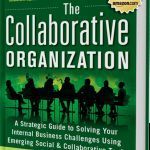
Many enterprises are struggling to adapt and evolve with today’s changes and culture and technology. Social media consultant Jacob Morgan’s new book, The Collaborative Organization: A Strategic Guide to Solving Your Internal Business Challenges Using Emerging Social and Collaborative Tools, takes on this challenge, providing a comprehensive strategy guide to emergent collaboration in the workplace. In anticipation of our upcoming webinar Making Enterprise Collaboration Work, we sat down with Jacob for some Q & A. 
Who inside a company would most benefit from the advice given in your book?
The book is written for those interested in workplace collaboration or who is in the process of deploying collaboration solutions. It is a vendor agnostic book that can positively impact any business. It was written for a senior level executive or decision maker but is also crucial reading for anyone who is an employee.
What type of collaboration tends to be most effective for sustaining a company and helping it grow: in-person collaboration, digital collaboration or a mix of the two?
You always need a bit of a mix between the two. Digital collaboration is great for things such as scale and managing information but there is no substitute to a face-to-face conversation or a handshake.
As you state in your book, many businesses have offices in different, even global, locations; digital collaboration tends to be less personal and indirect. How can companies mitigate this and help form stronger, more personal ties between locations?
It’s actually the weak ties that tend to be more valuable across enterprises because weak ties are the bridges between departments and geographies. Chances are that if you ask someone for something with whom you have a strong tie, you will have a strong overlap in terms of who that person knows and what he has access to. When you build weak ties – that is when you get access to new information, new ideas, new people, and new opportunities. The challenge for many global companies is that they have NO ties at all!
It’s not possible to maintain strong ties with everyone at a company, which is why weak ties are so valuable.
You talk about new collaboration technology. When is it right to think technology and when do you need to start with your specific business needs? What is the top risk associated with adopting social collaboration technology and how do companies avoid it?
Both the business need and the technology need to be thought out concurrently. They fuel one another. You can’t simply deploy a technology and assume your company will become collaborative, but at the same time focusing on the business side without addressing technology leaves room for improvement. You have to enable, not just educate, and a big part of enablement comes from technology. Employees need to see and use the platforms and understand the possibilities and opportunities.
What, in your opinion, is the number one mistake made by companies in the realm of collaboration and how can they mend this?
There are a few: lacking the proper leadership support (not just budget, but those who use the platform and encourage employees), deploying a technology before understanding why and the full benefits, and missing ways to support collaboration within the enterprise, outside of just technological deployment.
Who are the leaders in adopting social collaboration approaches and technology? What is their secret to success?
There are many companies doing great things but I can safely say there is no “secret sauce” among any of them. Every company has a unique set of business problems, approaches, technologies, strategies, etc. In some companies, this initiative comes from executives, in others, it comes from mid-level employees. In some companies, this starts out as a pilot deployed across the enterprise. It’s a chess game and no two games played are ever the same. Some of my favorite companies include TELUS, Lowe’s, Unisys, and Yum! Brands.
In your book, you state that e-mail is incorrectly used and has become a pseudo instant messenger. Where do you think e-mail should be embraced in a company (if at all) for effective communication and collaboration?
Email used to be for asynchronous communication. Someone sent you a message and you responded when you could (usually within 24 hours or so). Now we just wait for emails and respond to them. We get emails for everything and we are notified via push notifications when we receive them. It’s gotten to the point where we have to get notified that there is a note waiting for us. It’s similar to me calling you on the phone to tell you that I left you a voicemail. The second we get an email we respond to it and then we get another email right back; what was once used as form of asynchronous communication has become a glorified chat messaging tool!
But for most companies, email is not going to away anytime soon as it is one of the few unique identifying variables for people. It’s funny to think that even our names can’t set us apart anymore, but our emails can!
For more insights from Jacob Morgan, be sure to attend our upcoming joint webinar: Making Enterprise Collaboration Work. You can also download chapter 2 of The Collaborative Organization: A Strategic Guide to Solving Your Internal Business Challenges Using Emerging Social and Collaborative Tools
[image error]
July 31, 2012
Customer Relationship Management (and CRM) is Going Social

We live in a business world that is increasingly focused on improving customer experiences, but some companies lack the expertise and tools to make this happen. One of the best ways to create a better experience is to leverage what you know about your customers – and to do that, companies are moving towards an integration of social data with CRM systems. That’s why I was thrilled to join marketing and analytics superstars Leslie Poston, author of Social Media Metrics for Dummies and founder of Magnitude Media, Paul Gillin, B2B marketing expert, and Taulbee Jackson, CEO of Raidious, for CRM and Marketing webinar hosted by Social Media Today. I encourage you to check out the full presentation, moderated by CRM expert Brent Leary, titled “Next Generation CRM: Social Media Management and Marketing”. To get you started, I’ve highlighted key takeaways from our discussion on integrating social media and CRM strategies.
Over the last five years, a shift has occurred in customer relationship management. Paul Gillin informs us that at one time, CRMs were used as a sales force automation tool. As the technology and social landscape have evolved, so too did the role of CRM systems, which now collect behavioral data surrounding a customer or prospect’s social presence.
Since the birth of Facebook and other digital communities, social has been deemed a territory of the marketing and communication departments. As the landscape matures, companies are beginning to realize, and embrace, the medium’s wider potential. Social can play a vital role in customer service, customer feedback, and even product development. It’s critical for businesses to get social data out of a silo and into the hands of business leaders.
One of the challenges that arise with this explosion of newly available data is in determining how to best leverage it. For me, this reflects a process change. As the rise of social expands the conversation across many channels, it’s important to remain steadfastly focused on who and where your customers are. Leslie agrees, noting many companies will face process challenges as they look to integrate. She recommends working with a productivity expert to smooth the transition.
We all agreed that most companies are just at the beginning of social and CRM integration. Often when we hear about social CRM successes, it’s in reference to large brands like Target, who has created sophisticated segmentation strategies based on purchase behavior and lifestyle cues, or Amazon, the king of personalized recommendations. But for many other companies, a full integration is down the line; they are still perfecting the social listening. Paul referenced an eMarketer survey from December 2011, the results of which show 91% of companies having a one-way communication page on Facebook with 56% failing to respond to posts. Paul emphasizes the importance of fostering agility and nimbleness, while empowering employees to respond.
For Leslie, properly measuring the effects of the strategic integration of CRM and social data is a vital component in measuring success. She notes there’s no quick fix, but rather requires marketers to “massage” the data manually and by using various tools. She stresses the key metrics for your company will depend on what you are trying to drive. Taulbee echoes this sentiment. Raidious supported the Super Bowl Command Center in February 2012, relying on a cross-functional committee of over 70 people. In fact, Raidious worked in conjunction with the NFL, the CIA, and the FBI to quickly escalate any potential issues. By developing goals ahead of time, Raidious and the NFL defined what they hoped to impact and developed specific metrics that measured their success.
While there are certainly challenges ahead in the quest to integrate social media channels with CRM systems, it’s a really exciting time for our industry. Paul Gillin believes the race will go to the swift and encourages brands to start thinking about how to develop a system for listening to customers and for leveraging that data to drive organizational decisions. For access to our full discussion, listen in at Next Generation CRM: Social Media Management and Monitoring. Whether you’re part of a company leading the charge or one that could use a few tips, we would love for you to join this evolving conversation. As always, we encourage you to share your favorite takeaways from the webinar on Twitter at @AwarenessInc.
Mike Lewis
[image error]
July 30, 2012
The Future of Facebook: Bidding, Banks and Brand Behavior?

Have you heard the news? According to Eric Jackson, founder of Ironfire Capital, an event-driven activist hedge fund, Facebook will be gone by 2020. That’s quite a statement about a company who single-handedly redefined what it means to “like” something.
And what will bring this social media networking juggernaut down? The way Mr. Jackson sees it, it will be the continued emergence of the mobile web and Facebook’s struggle to adapt to this paradigm shift. Even Facebook has recently acknowledged mobile as a potential stumbling block for sustained growth.
To illustrate even further the possible decline of the social media giant, Facebook had its initial public offering on May 18th, 2012 and its stock opened at $38 per share. It quickly lost nearly a third of its trading value and closed at $26.90 and as of this writing is around $27 per share.
Facebook’s traffic has also taken a hit. According to comScore’s latest numbers, Facebook had 158.01 million unique visitors in the US in June, 2012, and that’s down from 158.69 million in April and 158.93 in March. All of these numbers may indeed suggest that Facebook has reached the peak of its appeal – at least for the time being.
So what is the future of Facebook? Will it follow Yahoo’s example and eventually fade into normalcy? Not if Facebook has anything to say about it. Here are some ways the company plans on staying competitive and relevant:
Bidding:
In an effort to address claims that it’s been struggling to come up with effective advertising, Facebook plans on launching Facebook Exchange – a real-time bidding tool that will let advertisers engage targeted users on the social network based on their browsing history.
According to TechJournal.com, researcher IDC estimated that real-time bidding will account for about $6.47 billion, or 27% of the projected $18.9 billion that will be spent on online display ads in the United States in the year 2015. As its stock has declined amid concerns about lagging sales growth, Facebook is definitely working to show advertisers its website is an effective way to reach consumers.
Banks
Another market Facebook plans to tap into is the online banking market. According to David Robinson, Facebook’s director of global marketing solutions and U.S. financial services, the company is looking to offer a solution to one-on-one personal engagement with banking institutions. Their first application, which is set to launch sometime in late 2012, will allow Facebook users who are Commonwealth Bank customers, to make payments to third parties as well as Facebook friends directly through the social media channel.
Brand Behavior
Andrew Lipman is V.P. of comScore Industry Analysis and is a proponent of the potential for brand marketing on Facebook. He was recently quoted in a comScore press release stating, “The Power of Like research sheds new light on how brands are able to deliver earned and paid media at scale, amplify its effects from Fans to Friends of Fans, and understand how exposure to these media can drive the desired consumer behaviors, including online and in-store purchase.”
Facebook allows brands to maximize the impact of their social marketing campaigns by leveraging a framework that assists in moving beyond Fan acquisition to delivering reach and measurable ROI. In this way, the social channel presents a unique marketing opportunity that serves as a platform for marketing communications that reach Fans as well as Friends of Fans.
In a recent study of brand media exposure using Facebook, it was found that Starbucks experienced an increase in sales by creating impactful social campaigns. And they’re not alone. Target also saw a cumulative lift in sales among exposed Fans and Friends of Fans, as did many other companies. These examples indicate that perhaps Facebook remains—and will remain— a major player in brand advertising.
The verdict is still out on the future of Facebook, but one thing is clear: the social networking giant is still a viable and powerful resource for individuals as well as businesses, and you can bet they won’t go down without a fight.
Photos are property of Facebook.
This guest post was provided by Jessica Edmondson who contributes on social media training and Internet marketing training for the University Alliance, a division of Bisk Education, Inc.
[image error]
10 Companies that Embrace Pinterest

Sharing with you a recent published article from LonghornLeads.com entitled, “10 Really Cool Companies that Embraced Pinterest”. Enjoy!
Currently Pinterest doesn’t have any sponsors… they don’t have pop up ads that bug you while you are looking at pictures to pin… in fact, they’re conspicuously devoid of any of the normal advertising routes that websites usually take on, which has been a major selling point among users. So, how do they make their money then? Venture capitalists. Pinterest has done an amazing job raising money for the site with venture capitalists so that, for the time being, they don’t need sponsors. And because Pinterest is one of the fastest growing social media sites out there, there have been a lot of companies that have jumped in and are making money from their involvement. Check out 10 really cool companies that embraced Pinterest.
Cache : This clothing and accessory company is showing the latest fashion trends through their Pinterest account. From fashion for career-minded women to displaying ideas for this year’s prom trends, Cache has managed to stay current and relevant on this social media site by appealing to everyone from teens to adults.
Taste of Home : Recipes and pictures of fabulous food are practically a corner stone of Pinterest, and it’s almost impossible to log on to the site and not start pinning as soon as you see a tantalizing photograph. Taste of Home has embraced this medium and is posting pictures and links to recipes, as well as making their recipe books and magazine available to the consumer online.
J Crew : J Crew is one of the more versatile clothing websites, showcasing trends for both men and women alike. By utilizing Pinterest, it’s easy for fashion savvy shoppers to find a style they like, click on the link, and purchase the outfit, making shopping a snap. From Pinterest to the J Crew website to your door, you don’t have to leave the house anymore to get great style. Unless of course you’d like someone to see how great you look in your cool new clothes.
Paper and Cake : This site sells everything you could ever want that is printable. If you’re throwing a party and want everything to follow a certain theme and be perfectly tied together and coordinated, then this is the place to get your stuff. They sell a little bit of anything and everything: banners, labels, tags, food signs, food picks, etc. They have a lot of ideas that are not only adorable, but that could also easily be replicated at your child’s next birthday.
Hayneedle : Hayneedle is a fun site that is full of a lot of unique and interesting products, and since it’s the unique products that typically do well on Pinterest it makes sense that the company has taken a keen interest in establishing a presence there. Just the other day on Hayneedle I found a rocking hammock, a hanging wine rack, and a chocolate fountain. An eclectic collection of quirky items? Sign me up!
Zappos Couture : Zappos is known for its wide selection of shoes, hand bags, and accessories, and is always on top of the latest trends and fashions. Their fun and quirky accessories are always a hit among fashionistas, and their upbeat company and solid business ethic has a knack for reeling customers in and creating customers for life.
Bagshug : This site carries hand bags that are similar to Coach bags, with the only noticeable difference being that they’re much cheaper. For those of us who are into all of the different shapes, sizes, and colors of purses, this website is a slam dunk. You can definitely find one appropriate for every look if not every outfit.
Fabulous Yarns : Beautiful yarns and fibers in every color and texture are available on this site. If you enjoy knitting or crocheting then Fabulous Yarn is your new go-to place. With their wide selection of yarns, you’ll be able to create beautiful, unique accessories for both yourself and your home… and who knows, you could even have a budding business in the making!
Restoration Hardware : Known for all of their one-of-a-kind furniture, hardware, and house accents, Restoration Hardware found a nice little niche in Pinterest. If you are trying to restore an older home and you need vintage hardware this is the place to look. They have everything you could ever need to complete this look, such as old knobs, door hardware, faucets, etc. Even if you don’t want the old original stuff they have reproductions that will allow you to have the convenience of modern amenities, but the aesthetics of the original.
Save on Crafts : Find all of the things that you’ll need to create beautiful weddings, receptions, parties and even gifts. From baskets to strings of lights or balloons, everything that completes a magical glow at your events can be found here.
[image error]
July 26, 2012
WWE vs. UFC: Social Lessons from the Winning Sports Brands
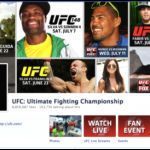
Social marketing best practice tips and strategic guides are easy to find, but it can also be beneficial to simply monitor the social channel of a successful brand to understand everything they do and why they do it. We did this in our latest white paper, Marketing Lessons from the Top Social Brands, where we used The Fan Page List (dubbed social media’s leading directory) to determine the top brands in sports, retail and services. Once the brands were identified, we sought to answer questions such as: What do these successful brands post? How often? What kind of imagery supports their brand? What content makes their audience tune in and take action?
WWE and UFC are the third and fourth most popular brands on Facebook by size, respectively. To show you how following every move of a brand for a week or so can provide insight into social marketing best practices, we offer a side-by-side comparison of the brands’ Facebook strategy below.
UFC
WWE
Facebook Fans
8,857,582
9,337,469
Fans Talking about Them
163,756
288,932
Engagement Rate (= #Fans talking about/ #Followers)
1.84%
3.04%
Profile/Cover Photo:
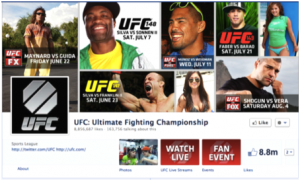
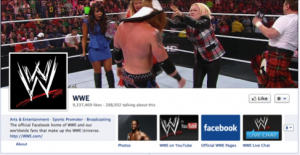
Tabs:
Photos, Likes, Live Events, Live Streams of Fights
Photos, YouTube, Official Page Listings, Live Chat
Frequency of Posting
1-5 posts per day.
10-15 times per day.
Top Content Types
UFC aggressively promotes individual fights and links viewers to the website to pre-order access to the fight.The UFC also features fighters and links users to their individual pages.UFC promotes UFC.com and the UFC YouTube channel often in their posts, keeping fans engaged with their content.Photos are utilized in nearly every post to keep engagement levels high.
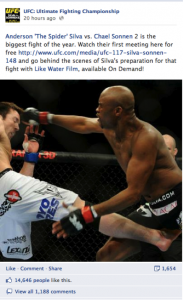
WWE posts information on upcoming fights and fan contests like ‘Who is the Best WWE World Champion?’ – which links to their website. They also share the history of WWE through photos and stats. One of the most engaging types of content feature the WWE stars, using photos, videos and news stories.The WWE drives social traffic back to their website, in the majority of instances. This is important, because they keep the traffic they are generating.Photos are used extensively to create engaging posts.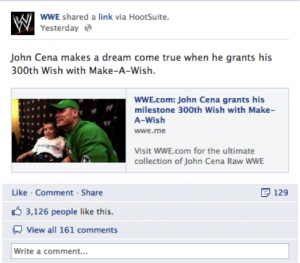
Contests/Giveaways
The UFC runs contests, like offering fans a chance to win a prize pack of merchandise by listening to UFCRadio.com.UFC recently ran an incredibly successful campaign using Spotify and Facebook. On Spotify, fans listened to two songs that contestants of the UFC reality show The Ultimate Fighter would walk out to on the season finale. Then, fans voted on their preferred choice on Facebook.
Limited contests and giveaways. Instead the WWE focuses on sharing the 1,500 unique pieces of content created weekly.
Website Integration:
Social feeds are integrated on the UFC website and articles include sharing functionality. They have some other interesting integrations: by liking Facebook, fans can watch a fight for free.
Social feeds are integrated on the WWE website, and each article includes sharing functionality.
How Social Leads to Revenue:
First and foremost, UFC is using social to grow and engage their TV audience – pointing fans to pay-per-view order form. UFC uses social to feature promotional items in their posts, including merchandise and fight sales. The UFC also frequently drives Facebook fans to order pages for fights, driving sales and revenue.
First and foremost, WWE is using social to grow and engage their TV audience. The WWE includes a link to the WWE store on their Facebook page. Additionally, with the highly engaged audience visiting their website, they are able to drive increased sales.
*Photos and Fans as of June 22nd.
How are these brands doing offline? Credited to UFC programming, their home network FUEL TV posted the ‘largest year-to-year percentage increases in prime time and total day last month (compared to May 2011) and through the first five months of this year (compared to Jan. – May 2011) in its target audience of M18-49, total viewers and households, among all rated, ad-supported cable networks in the U.S.’ In comparison, WWE programming reaches approximately 12 million viewers in the U.S. each week.
What’s your take? Who does it better: UFC or WWE? Thinking about your own social marketing efforts, how do you stack up against your closest competitors? Tell us at @awarenessinc.
For more tips and best practices from the leaders in retail, sports and services, download our free white paper, Marketing Lessons from the Top Social Brands.
[image error]
July 24, 2012
The Marketing Case for Pinterest and How to Use it Successfully

Pinterest – the virtual bulletin board that allows users to store and share images and links they find interesting or inspiring – grew to over 10 million active users faster than any standalone website. It immediately secured its place as the social media darling of 2012, and for good reason. But as a business owner or marketing manager you may be wondering, “Is Pinterest right for me?”.
We’d advise it’s time for you to consider Pinterest as an integral part of your social marketing effort, right next to the Big 3 - Facebook, Twitter, and YouTube. Here’s why: businesses that have effectively used Pinterest as a marketing tool have experienced higher referral traffic, higher quality leads, more sharing through Facebook and Twitter, and increases in sales. Read on to learn how you can successfully market on Pinterest, and follow the example set by the companies that have increased their social reach and sales as a result.

Quick Tips to Improve Your Pinterest Presence
Increase Your Social Reach – Social reach is about expanding the number of people your brand can tap into across different social platforms, and Pinterest offers a substantial opportunity for finding new customers. Optimize your social reach by publicizing your Pinterest page on all other social platforms, embedding Pinterest widgets or buttons on your company’s website, and consistently creating pin boards that are populated with images unique to your brand.
Increase Content Engagement – As with any social channel, engaging content is vital to a successful social media strategy. Captivating visuals are often the most important piece of the Pinterest puzzle, so don’t hesitate to showcase your best assets. Photos, product packaging, and infographics can provide the visual boost that will grab the attention of your followers and attract new ones.
Identify and Engage (P)Influencers – Identify the users that are top pinners on topics relevant to your brand with tools like PinReach and PinPuff. Both tools also measure the social reach of individual pins and pinners. Use this information to craft off-line relationships with your top pinners. Honda and Kotex both delivered special care packages to their top pinners, based on the kinds of products they pinned.
Increase Lead Generation – The goal of an effective Pinterest page should be to drive traffic back to your website. Achieve this by creating catalogs of pin boards and pins based on your products. Retail brands should add prices to their products on Pinterest to attract qualified buyers. Give your followers a mix of lifestyle pins and catalog or product pins to increase lead generation while maintaining engagement.
Apply Analytics to Know What Works – Learn what makes your followers returning visitors by studying referral traffic, conversions, and visitor demographics in Google Analytics. Tools such as Repinly and Pintics can also be used to analyze your competition and optimize traffic to your site.
Companies Effectively Using Pinterest
Ideeli – The retail daily deal site Ideeli creates pin boards that showcase products from their website, and they also incorporate uplifting images and quotes from blogs. This has done wonders for their company. According to Mindjumpers, web traffic has increased by 446% and sales five-fold as a result of using Pinterest as part of their marketing strategy.
Whole Foods Market - Whole Foods understands the importance of compelling content on Pinterest. They know their customers’ passions and interests and have successfully designed their pin boards to appeal to the environmentally conscious, the home cooks, and everyone else in between. Notable pin boards include ‘Whole Planet Foundation’ and ‘We’re used to reusing!’.
For more information on how to use Pinterest to as an integral part of your social marketing strategy, download our free e-book, Beyond the Big 3: Five Killer Strategies to Dominate LinkedIn and Pinterest.
Are you using Pinterest as part of your brand’s marketing strategy? Have you seen an increase in traffic, leads, social reach, and sales as a result? Don’t be shy, share your experience in the comments or tweet to @awarenessinc!
@BostonMike
[image error]
July 19, 2012
Facebook Facing Mobility Questions Following IPO

A public stock offering, a marriage to his long-time girlfriend, and questions and more questions. Those are just a few of the things Facebook CEO Mark Zuckerberg has been dealing with over the last month.
While Zuckerberg has had a lot on his plate of late, he is no doubt keeping his ears to the ground as to how Wall Street is viewing the now famous IPO. Analysts, in turn, are now speaking out as to how they view the public stock offering that has had the social media giant in the news for weeks now.
On June 27, a number of Wall Street analyst reports hit the streets, with many showing reserved optimism for the company’s IPO.
To return to where this all started, let us remember that on May 18, Facebook became the first U.S. business to debut with a market value of greater than $100 billion. Under securities law, the 33 banks that participated in the company’s IPO had to wait that long prior to publishing their thoughts.
Reports from leading financial institutions such as Morgan Stanley and Goldman Sachs seem overall upbeat regarding the long-term outlook for Facebook, given its approximately 900 million users. A large number of analysts also believe Facebook can snag a major piece of the Internet advertising market pie.
With that being said, it does not mean that there are not potential detours in the road for Zuckerberg and his baby if you will.
Some analysts and social media experts believe one of the biggest challenges to the company’s ability to grow over time is locating a growing source of revenue, particularly from the ever-increasing mobile sector.
According to analysts from BofA Merrill Lynch, “The company is in the midst of a mobile usage transition and we are cautious on Facebook’s revenue trends until new mobile ad revenue models start driving the top line.”
Facebook revealed the issue regarding mobile advertising in a Securities and Exchange Commission (SEC) filing. The document, called an S-1, or S-1/A when amended, mandates that a business provide investors with insights, including potential risks, of investing.
According to a story in The Wall Street Journal, the S-1/A filing included the following language: “If users increasingly access Facebook mobile products [...] and if we are unable to successfully implement monetization strategies [...] or if we incur excessive expenses [...] our financial performance and ability to grow revenue would be negatively affected.”
The bottom line is that you can bet Zuckerberg and Co. are heavily invested in thinking about how they can grow Facebook through mobile advertising going forward.
With money to spend, there is little doubt that Zuckerberg will open his wallet to the right purchase if it involves increasing his company’s ability to monetize mobile advertising.
And here you thought being a billionaire did not come with facing challenges along the way.
Photo credit: windows8update.com
Author Miguel Salcido has been an SEO professional for over 9 years, holding Director and VP positions at large agencies. Now he runs an organic SEO consulting agency and loves debating about SEO ranking factors so feel free to reach out to him for a lively debate.
[image error]
Top 5 Online Marketing Mistakes


Top 5 Online Marketing Mistakes Infographic >>
[image error]
Top Social Marketing Lessons from Leaders in Sports, Retail, and Services (Infographic)

In our latest marketing white paper, Social Success Stories: Marketing Lessons from Industry Leaders, we analyzed the top social brands in retail, services and sports to identify and share their best-in-class strategies for success. We reviewed their social presence and analyzed the content strategies used by social marketing leaders such as Converse, Whole Foods, NBA, ESPN, Farmers Insurance, and American Express, on the two most popular social networks, Facebook and Twitter. We left no strategy unturned – and we shared the answers to the following questions: What do these successful brands post? How often? What kind of imagery supports their brand? What content makes their audience tune in and take action?
This infographic distills some of the best practices to help quickly jumpstart your marketing campaigns. For the full set of strategic lessons, be sure to download the free paper.
We want to hear from you!
With which brand to you most closely identify? Will you apply some of these learnings to your own campaigns? Let us know on Twitter at @awarenessinc.
[image error]


